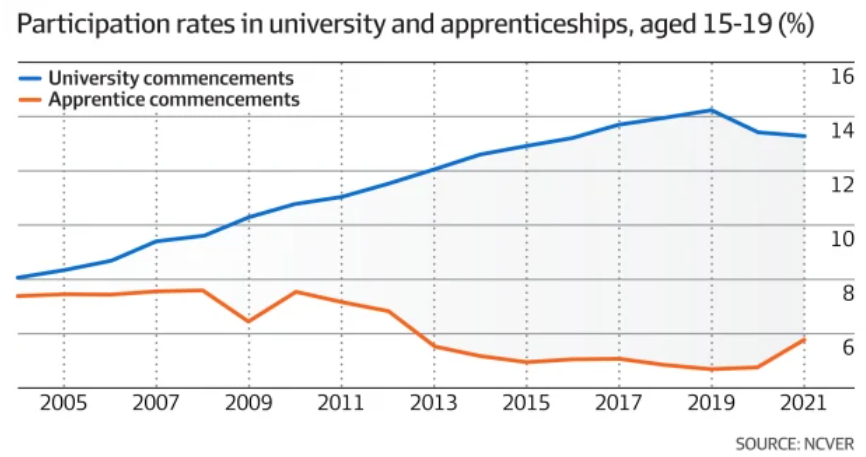The Albanese government released the Australian Universities Accord Final Report in February, which announced the following higher education attainment targets:
- By 2050, Australia’s tertiary education attainment rate is expected to reach at least 80% of the workforce, up from 60% today.
- The proportion of Australians aged 25 to 34 having tertiary education is expected to rise from 45% to 55% by 2050.
- By 2050, the proportion of adults aged 25 to 34 with a tertiary-level vocational or technical qualification increase to 40%.
The report noted that “the system will need to more than double the number of Commonwealth-supported students in universities from 860,000 currently to 1.8 million by 2050” to achieve its 55% university attainment target.

This would require a high share of students from lower socioeconomic backgrounds to graduate from university.
Employers of apprenticeships have warned of rising trade shortages as the federal government encourages more high school graduates to pursue higher education.
The National Australian Apprenticeship Association (NAAA) wants more young Australians to pursue a trade instead.
The NAAA questions the Albanese government’s plan to pay universities $18,278 to provide remedial bridging courses for every disadvantaged student who is trying to get into a degree at a $350 million cost to taxpayers over the next four years.
NAAA chief executive Ben Bardon claimed that discouraging students from undertaking apprenticeships is “taking ability and just burning it’’.
“The period of uncapped places at university, and expanding the number of people going to university, has seen a much higher dropout rate (from degree courses)”, he said.
“The dropout rate for these cohorts, particularly where the individual student has an ATAR score below 75, is roughly double the average university dropout rate’’.
“There is a substitution effect where students who may otherwise have undertaken an apprenticeship are attracted to university courses they then subsequently fail to complete”, Bardon said.
Similarly, Denita Warn, CEO of Master Builders Australia, warned recently that a preference for university education over apprenticeships has exacerbated skill shortages.
Warn argued that a movement to encourage more people to pursue higher education began in the 1970s, exacerbating the prejudice against trade apprenticeships in favour of universities.
The Australian’s Judith Sloan also warned that Labor’s 55% university target will likely reduce productivity via increasing credentialism.
“Is someone with a bachelor of arts in cultural studies really more qualified than a plumber?”, Sloan asked.
TAFE and vocational education have already dropped in popularity due to public funding being diverted to universities.

This has led to ongoing skill shortages across a variety of areas, particularly the trades.
To meet its 55% university attainment target, the federal government would need to cut entry standards even further to recruit non-traditional university students. As a result, trade-related shortages would worsen.
Prioritising universities above vocational or trade schools was never in the national interest, either socially or economically.
This favouritism toward universities will intensify under Labor’s new Universities Accord, exacerbating skill shortages across the Australian economy.
It would also result in students incurring greater debts for increasingly irrelevant degrees.

